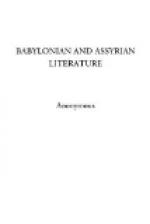CHALDEAN HYMNS TO THE SUN
TRANSLATED BY FRANCOIS LENORMANT
The sun-god, called in the Accadian Utu and Parra (the latter is of less frequent occurrence), and in the Semitic Assyrian Samas, held a less important rank in the divine hierarchy of the Chaldaic-Babylonian pantheon, afterward adopted by the Assyrians, than the moon-god (in the Accadian Aku, Enizuna, and Huru-ki; in the Assyrian Sin), who was even sometimes said to be his father. His principal and most common title was “Judge of Heaven and Earth,” in the Accadian dikud ana kia, in the Assyrian dainu sa same u irtsiti. The most important sanctuaries of the deity were at Larsam, in southern Chaldsea, and Sippara, in the north of Babylonia.
Some few fragments of liturgical or magical hymns addressed to Shamas have come down to us. These are five in number, and I give a translation of them here. They have all been studied previously by other Assyriologists, but I think the present interpretation of them is superior to any which has as yet been furnished.
The following are the chief bibliographical data concerning them:
I. The primitive Accadian text, accompanied by an interlinear Assyrian version published in the “Cuneiform Inscriptions of Western Asia,” Vol. IV, pl. 20, No. 2. I put forth a first attempt at a translation in my “Magie chez les Chaldeens" (p. 165), and since then M. Friedrich Delitzsch has given a much better explanation of it ("G. Smith’s Chaldaeische Genesis," p. 284). Of this hymn we possess only the first five lines.
II. The primitive Accadian text, with an interlinear Assyrian version, is published in the “Cuneiform Inscriptions of Western Asia,” Vol. IV, pl. 19, No. 2. M. Delitzsch has given a German translation of it in “G. Smith’s Chaldaeische Genesis” p. 284, and a revised one in English has just appeared in Prof. Sayce’s “Lectures upon Babylonian Literature,” p. 43.
III. A similar sacred text, published in the “Cuneiform Inscriptions of Western Asia,” Vol. IV, pl. 28, No. I, in which the indications as to the obverse and reverse of the tablet are incorrect and ought to be altered. The two fragments left to us, separated by a gap, the extent of which it is at present impossible to estimate, belong to an incantatory hymn destined to effect the cure of the king’s disease. Interpretations have been attempted in my “Premieres Civilisations” (Vol. II, p. 165 et seq.), and in the appendices added by M. Friedrich Delitzsch to his German translation of G. Smith’s work, already cited.
IV. The primitive Accadian text with an interlinear Assyrian version, published in the “Cuneiform Inscriptions of Western Asia,” Vol. IV, pi. 17, col. I. This hymn, like the preceding one, is intended to be recited by the priest of magic in order to cure the invalid king. I gave a very imperfect translation of it in my “Magie chez les Chaldeens” (p. 166).




